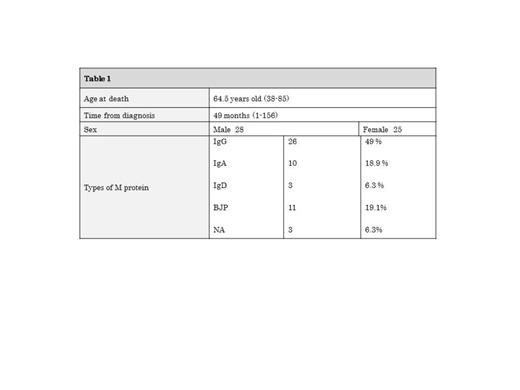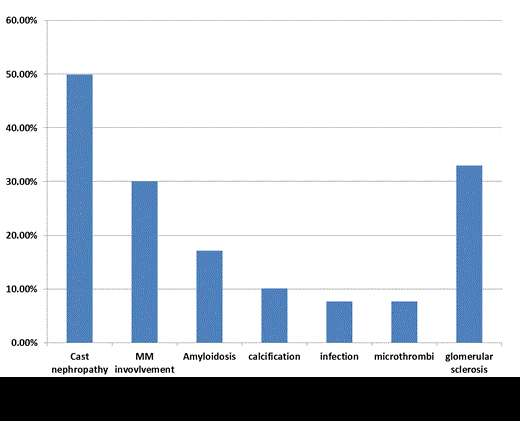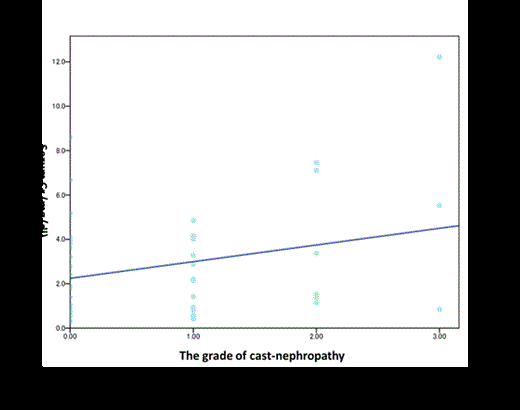Abstract
Background
Renal injury is a common complication in multiple myeloma (MM). Myeloma cast nephropathy is the most common lesion and this is caused by excessive light chains binding to uromodulin. Other than cast nephropathy, renal calcification, renal amyloidosis, and direct tumor cell involvement have been noticed. However seldom had previous reports addressed the issue of severity of histopathologic findings. Therefore, this study investigates the extent of each renal pathological finding, and examines the correlation of such severity and clinical findings in autopsied cases. This may offer understanding of renal injury in patients with MM from another angle, since similar approach had rarely been taken.
Patients and methods
Fifty-three sequential autopsies performed on patients died of MM at our hospital, were analyzed. The kidneys were evaluated by light microscopy using hematoxilin-eosin-stained sections as well as Congo red stain when amyloidosis was suspected. When the cast nephropathy and/or invasion of MM cells are identified, we described their severity. In the case of cast nephropathy, if the cast is formed in the fraction of the tubules they are defined as class1, if the casts are existed diffusely, they are class2, and if the diffuse casts are associated with interstitial atrophy, they are class3. When local MM invasion was found, this was defined as class1, diffuse involvement class2, and when the basic constitution of nephron is collapsed by MM involvement they are class3. Other histopathologic findings such as renal calcification, microbial and fungal infection, micro thrombo-embolism, and arteriosclerosis were also recorded.
Results
Patients, characteristics are shown in the table. Median age at autopsy was 64.5 years old. Durie & Salmon stage: Almost all cases were at stage III, M-protein: IgG/IgA/IgD/BJP/uncertain=26/10/3/11/3 cases. Median overall survival was 49 months. Seven of 53 patients manifested as plasma-cell leukemia.
The most common renal lesion was cast nephropathy (49.9%). We found 63.4% of them were categorized as class 1, 28.4% class 2, 9.2% class 3. Plasma cell tumor involvement was found in 30.0% of 53 cases. Seventy nine point six per cent of them were class 1, 2.4% class 2, 18.0% class 3. Other findings include, Al-amyloidosis (17.1%), renal calcification (10.1%), microbiological and fungal infection (7.7%), micro thrombo-embolism (7.7%). Thirty-three per cent of the patients had the glomerular sclerosis which involve more than 20“ of the glomerulus (Figure. 1).
As shown in the Figure. 2 the severity of cast-nephropathy was significantly correlated with serum creatinine level (r=0.278, p=0.048). Longer overall survival was found in patients who hadrenal involvement of the kidney (56.5 months vs 46.8 months. p=0.012). MM cells invaded more profoundly when there was evidence of plasma-cell leukemia (class 1.43 vs class 0.41. p<0.01).
Discussion
This study clearly showed that cast nephropathy was the most common renal manifestation. This was comparable with previous reports. However, there were larger numbers of cases with myeloma invasion in kidney than expected, and more profound MM invasion was found in cases with plasma-cell leukemia. This indicated that MM can directly invade kidney in the end-stage of MM.
Long term survivors tended to have increased incidence of renal direct invasion of MM. This may reflect the natural history of MM.
We found correlation between severity of cast nephropathy and serum creatinine.
Together, these findings may provide the framework for future direction.
No relevant conflicts of interest to declare.
Author notes
Asterisk with author names denotes non-ASH members.




